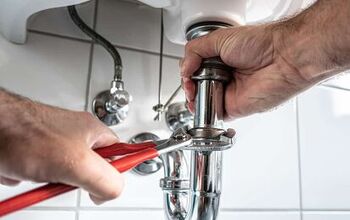Ways To Keep Your Dog Safe And Warm Outside This Winter

Dogs look forward to snow days more than children. They love frolicking in the yard in the fresh powder, and eating it until their tongues are cold. While many dogs love snow and the cold weather that accompanies it, it’s crucial that, as a dog owner, you do all you can to keep your dog safe and warm during the cold winter months.
You must keep your dog safe and warm when it’s outside in the winter. Allow your dog's natural coat to grow, and don’t cut it during the winter. Buy insulating clothes for your dog, build a warm outdoor shelter, and keep its paws clean and warm, especially when it snows. Keep your dog hydrated, never leave it unattended outside, and ensure you know the warning signs of cold-related illnesses.
Dogs are smart, but they aren’t always great at letting you know when they are cold. Therefore, you must do all you can to ensure your dog stays warm and safe all winter long. If you live in a cold climate and have a pooch that loves the outdoors, make sure you keep reading to learn all the best ways to keep your furry friend safe and warm when it’s cold outside.
12 Ways To Keep Your Dog Protected And Warm In The Winter
1. Buy Your Dog Winter Clothes
If you’re worried about your dog getting cold when it goes outside in the winter, one of the most logical things to do is to put clothes on your pooch. Clothes can be fun and funny to put on your dog, but in the winter, clothing serves a very practical purpose.
If you have a dog with very little fur, clothing is essential to help keep it warm. Make sure you get jackets that insulate your pup, not just ones that look cute. Some dogs aren’t huge fans of clothing, so make sure your pet is comfortable in whatever you choose, so it doesn’t try to rip it off right away.
2. Never Leave Your Dog Unattended On A Cold Day
If you have a fenced-in yard, you may be in the habit of letting it run around outside unattended. While this may be safe when the weather is pleasant, it’s potentially dangerous in cold weather.
You should always keep an eye on a dog when it’s cold. This will make it easier to notice if your dog is showing signs it’s cold. If it’s snowing, this is even more important, since dogs can get trapped in snow and will get cold faster than they may realize.
3. Keep Dog Away From Ice Melt Chemicals
Snow is white and may look pure and pristine, but some toxic chemicals go hand-in-hand with snowfall. Antifreeze and ice melt are very toxic for dogs. Since dogs love snow and these chemicals can be found in the snow, you must be extra diligent in keeping your dog away from these chemicals after a snowstorm.
4. Heat Your Outdoor Porch
If you have an outdoor space that you use throughout the year, consider warming it up for you and your dog. There are many ways to winterize a porch to warm it up. This will allow your dog the chance to enjoy an outdoor atmosphere outside the main house without risking hypothermia.
5. Keep Your Dog On-Leash On Snowy Trails
If you plan on taking your dog on a walk when there’s snow on the ground, make sure you keep it on a leash. Dogs tend to love wandering off the beaten path, especially once it’s snowed.
While this isn’t always dangerous, it is easy for your dog to step somewhere unsafe when the ground is covered in snow. There can be deep holes, sharp objects, and other hidden dangers lying under the snow.
6. Ensure Your Pooch Stays Hydrated
Hydration might not be the first thing on your mind when walking your dog on a cold day, but dogs can easily get dehydrated when it’s cold. Cold weather is often dry, and if your pet is running around to stay warm, it can get dehydrated fast. Ensure you always have water on hand whenever you are active with your dog.
7. Skip The Haircuts Until Spring
If you usually take your dog to the groomer for a trim every month or so, you may want to alter this schedule in the winter. Dogs should maintain their full winter coat when it’s cold. After all, that’s what their coat is for.
You can still wash and groom your dog as normal but avoid cutting its hair until the weather warms up. This is a great natural way to keep a dog warm in the winter.
8. Shovel An Area In Your Yard After A Snow Storm
Some dogs, especially smaller dogs, struggle to walk outside and use the bathroom after a snowstorm. If this is the case, then shovel a small area near the door where you let your dog out normally.
This will allow your pet the space to use the bathroom without getting covered from head-to-toe in snow. You can also add a patch of artificial grass close to your door. This will allow your dog in the yard to “do its business” without having to venture far when it’s cold, snowing, or both.
9. Build A Winter Shelter For Your Pet
If your winters aren’t too frigid, your dog may prefer to stay outside in the winter. To ensure your dog doesn’t get cold while it's outside, you may want to build it a shelter. You can build a simple shelter, or if the weather can get cold, you can insulate it so your dog stays warm in it no matter how low the temperature dips.
10. Know The Warning Signs Of Cold-Related Illnesses
The best way to protect your dog from the dangers of cold weather is to know all the warning signs of hypothermia and frostbite in dogs. This will help you determine if you need to get your dog somewhere warm, or even bring your pet to a veterinarian.
The most common signs of hypothermia include shivering, rapid breathing, slow movement, and difficulty walking. If you notice a change in the color of your dog's skin, fur, or paws, this could be a sign of frostbite.
11. Wash, Clean, And Protect Your Pet’s Paws
Your dog’s paws are perhaps the most vulnerable part of its body in the cold. A dog's paws directly interact with the cold ground, making them susceptible to extreme cold. Paws are also exposed to winter chemicals and salts that are put down to melt ice and snow.
To protect your dog’s feet, you may consider putting booties on your pet in extremely cold conditions when there is a lot of outdoor walking. Make a habit of washing, cleaning, and moisturizing your dog’s paws after winter walks. This will keep your dog and its paws safe and healthy.
12. Schedule Walks For The Warmest Time Of Day
Your dog must stay active, even when the weather isn’t the best. Don’t give up on outdoor walks altogether in the winter. Instead, opt to walk your dog during the warmest and sunniest parts of the day.
Look at the forecast and plan longer walks on days when the weather looks best, and shorter ones when temperatures dip low or it snows. This will help keep both you and your dog healthy and warm throughout the winter.
Final Notes On How To Keep Your Dog Safe And Warm In The Winter
The winter months can be difficult for dog owners. It’s much more challenging to take your dog outside and ensure its safety. Still, if you follow some simple rules, your dog should be warm and safe all winter long. Consider buying your dog warm clothes or building it an outdoor shelter. Keep its paws clean, and keep your pup hydrated. Walk it during the warmest time of day, never leave your pet unattended outside, and ensure you know the warning signs of cold-related illnesses.
Related Guides:

Tom Gaffey is an expert writer who currently resides in Washington D.C. Tom has a passion for real estate and home improvement writing, as well as travel and lifestyle writing. He lived the last twelve years in Hawaii where he worked closely with luxury resorts and event planners, mastering his knowledge of aesthetics and luxury products. This is where he found his passion for home improvement and a keen interest in DIY projects. Currently, Tom resides in Washington D.C, and also working on his debut fiction novel.
More by Tom Gaffey














![The 5 Best Angle Grinders – [2022 Reviews & Buyer's Guide]](https://cdn-fastly.upgradedhome.com/media/2023/07/31/9071326/the-5-best-angle-grinders-2022-reviews-buyer-s-guide.jpg?size=350x220)












